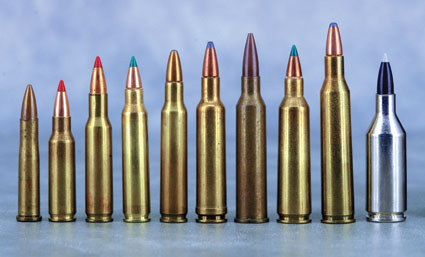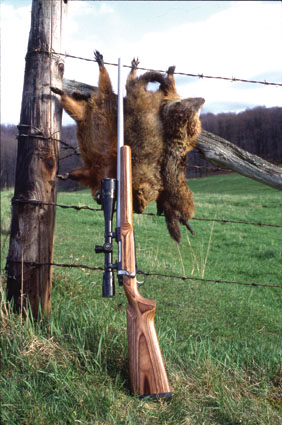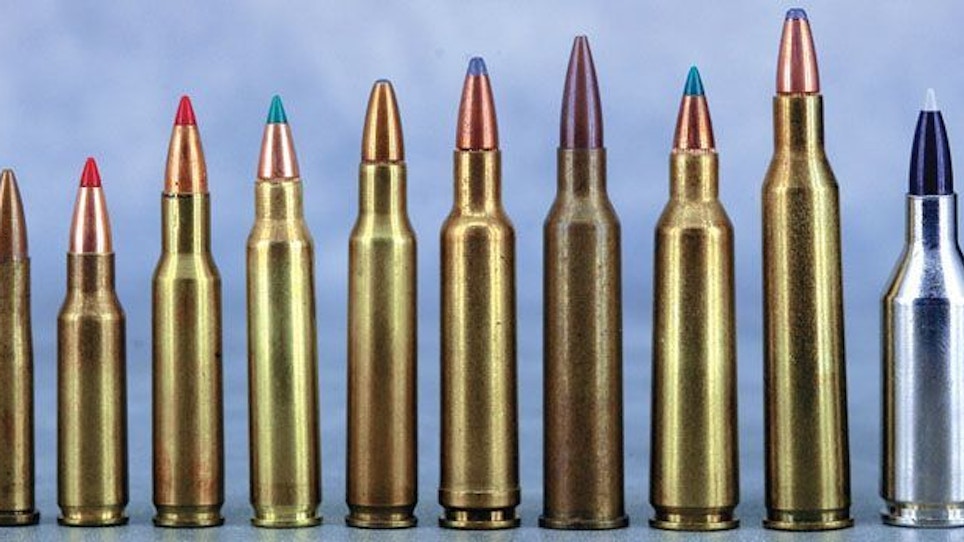 I’ll bet, for the vast majority of us, a .22 rifle played a key role in our development into hunters and shooters. Rare is the man or woman who in adulthood suddenly develops an interest in guns and hunting without having experienced that “right-of-passage” if you will, that we went through as youngsters with a .22 rifle. I suppose that predisposes us to the caliber.
I’ll bet, for the vast majority of us, a .22 rifle played a key role in our development into hunters and shooters. Rare is the man or woman who in adulthood suddenly develops an interest in guns and hunting without having experienced that “right-of-passage” if you will, that we went through as youngsters with a .22 rifle. I suppose that predisposes us to the caliber.
Heritage Of The .22
I’m sure most PX readers are aware that the .22 is the caliber that launched the era of the self-contained metallic cartridge in America. It all started in 1856 when Messrs. Smith and Wesson introduced the .22 Short rimfire cartridge in conjunction with their First Model revolver. Over the next 30 years the .22 Long, Long Rifle, and Extra Long were introduced, plus a jillion other rimfire cartridges ranging all the way up to .58 caliber. With the exception of the various .22’s, however, the rimfire’s time in the sun was brief. By the mid-1870’s centrally-primed, reloadable cartridges began to appear, first in Europe as military rounds, then here. Our own .45-70 Gov’t. was spawned in 1873 and is still alive and kicking today, some 133 years later!
The self-contained metallic cartridge actually reached its current state of development in 1886 with the 8mm French Lebel, the first cartridge to use smokeless powder in conjunction with a jacketed bullet. We’ve certainly refined the process since then, but with the exception of the spitzer bullet first developed by the Germans in 1902, basic cartridge components have changed little over the last century.
The Black Powder To Smokeless Shift
The .22 centerfires got their start in the smokeless powder era by way of the .22 WCF (Winchester Center Fire). Introduced in 1885 in conjunction with the equally new Winchester Model 1885 single-shot rifle, it was initially loaded with black powder, as were all cartridges back then. Eventually, a smokeless-powder load was developed that duplicated its black powder ballistics, a 45-grain bullet at 1,550 fps. Performance-wise, that put the .22 WCF mid-way between the .22 LR and the much later .22 WMR of 1959.
The first smokeless .22 centerfire designed as such was the .22 Savage Hi-Power of 1912; it sent a 71-grain bullet on its way at nearly 2,800 fps, making it the first true “high velocity” .22. The only commercial rifle in America chambered for the Hi-Power was the Savage 99, a lever action that in larger calibers like the .250 and .300 Savage was immensely popular among deer hunters during the first half of the 20th century. As a varmint cartridge, the Hi-Power would have been better suited to bolt action rifles, but by the time that action type came into preeminence after WW II, there were better .22 centerfires to be had.
The Bee And Zipper
Much the same could be said for the .219 Zipper and .218 Bee, two more varmint cartridges introduced by Winchester in 1937 and 1938, respectively. The Zipper debuted in the Model 64 lever action rifle, and the Bee the following year in the Model 65, also a lever action. Considering the guns, neither round was very accurate, plus their top-ejection made mounting any sort of scope impractical. The fact that both were designed for lever action rifles is another testament to just how popular that action type was back then. As was the rule rather than exception with new .22 centerfires, both the .219 Zipper and .218 Bee were derived from older, existing cases. The .219 was formed by necking down the old Winchester .25-35 hull, and the Bee by necking down .25-20 brass.
The Hornet
 Far more influential than either the Zipper or Bee on the varmint-hunting community was the diminutive .22 Hornet, developed in the late 1920’s by a small group of ballistic experimenters at the Springfield Armory, most notably Col. Townsend Whelen and G. L. Wotkyns. Winchester commenced commercial production of ammunition in 1930, though no commercial rifles were produced for the cartridge until 1933. Like the Zipper and Bee, the Hornet was based on an established case, in this instance the .22 WCF. The same mistakes Winchester made with the Zipper and Bee were not made with the Hornet. The commercial rifles chambered for the tiny round during the 1930’s were bolt actions, though Steven’s did add the chambering to its Model 417 “Walnut Hill” single-shot target rifle. Because of the inherent accuracy of the guns offered in the caliber, the Hornet quickly established a reputation for accuracy. The only problem was that its 45-grain payload at 2,690 fps wasn’t exactly the barn-burner cartridge needed for long-range varmint hunting, particularly groundhogs in the east, and marmots in the west. For those applications, the Hornet was only effective to about 150-175 yards.
Far more influential than either the Zipper or Bee on the varmint-hunting community was the diminutive .22 Hornet, developed in the late 1920’s by a small group of ballistic experimenters at the Springfield Armory, most notably Col. Townsend Whelen and G. L. Wotkyns. Winchester commenced commercial production of ammunition in 1930, though no commercial rifles were produced for the cartridge until 1933. Like the Zipper and Bee, the Hornet was based on an established case, in this instance the .22 WCF. The same mistakes Winchester made with the Zipper and Bee were not made with the Hornet. The commercial rifles chambered for the tiny round during the 1930’s were bolt actions, though Steven’s did add the chambering to its Model 417 “Walnut Hill” single-shot target rifle. Because of the inherent accuracy of the guns offered in the caliber, the Hornet quickly established a reputation for accuracy. The only problem was that its 45-grain payload at 2,690 fps wasn’t exactly the barn-burner cartridge needed for long-range varmint hunting, particularly groundhogs in the east, and marmots in the west. For those applications, the Hornet was only effective to about 150-175 yards.
.220 Swift
While the Hornet remains the most anemic .22 centerfire to date, Winchester more than made up for it just five years later with the introduction of the .220 Swift in 1935. Not only did the Swift break the 3,000 fps barrier, it broke the 4,000 one as well. Launching a 48-grain bullet at 4,110 fps, the Swift literally set the shooting world on its ear. No other .22, let alone any cartridge of larger caliber, approached that kind of velocity.
According to Barnes’ Cartridges of the World, the initial development work with the Swift was conducted by G. W. Wotkyns of .22 Hornet fame, using the .250 Savage case necked down to .224”. That, of course, essentially describes what would eventually become the wildcat .22-250 Varminter, and ultimately the .22-250 Rem.
For whatever reason, Winchester decided to base the Swift on an older and more primitive semi-rimmed case that was the basis for the experimental 6mm Lee-Navy round developed for the U. S. Navy in 1895 in conjunction with the Lee straight-pull rifle. The parent cartridge was never adopted, but some commercial rifles were chambered for the round and ammo was loaded commercially by Winchester until 1935.
The .22 Glory Days
The modern era of .22 caliber varmint cartridges really began in 1950 with the introduction of the .222 in Remington’s Model 722 bolt action rifle. Here was a cartridge based on a totally new case with a rimless head diameter of .378”. Proportionally, it looked like a miniature .30-06. The “Duece” as it would soon be dubbed, fired a 50-grain bullet at 3,140 fps, which was quite impressive considering the diminutive size of its case, but miles behind the .220 Swift. Apparently that didn’t matter, for shooters took to the Duece like no other varmint round in history. Even by today’s standards the .222 Rem. in Remington’s Plain Jane Model 722 rifle was phenomenally accurate for a factory ammo/rifle combination, and the growing ranks of handloaders made it even more so. The .222 set accuracy standards for all the varmint cartridges that were to follow.
And follow they did – the .222 Rem. Magnum in 1958; the .224 Weatherby Magnum in 1963; the .225 Win. and .223 Rem. in 1964, and the .22-250 Rem. in 1965. Of the aforementioned cartridges, only the .223 and the .22-250 had any significant, lasting impact on the .22 centerfire scene. The .222 Rem. Magnum had no chance at survival once the government made the decision to adopt the .223 as its official cartridge, If there’s one sure-fire ticket to immortality, it’s a military chambering. Okay, so the .30-40 Krag didn’t make out too well, but look at the .45-70, .30-06, and .308 Win. Besides, the .223 pushed the same 55-grain bullet at nearly the same velocity as the .222 Magnum, so it wasn’t like shooters were giving up a lot.
Once the .22-250 was legitimized by Remington in 1965, there was little reason to opt for the .225 Win. because it fell 150 fps short by comparison. So too did the .224 Weatherby, with its added handicap of being a proprietary cartridge available only in Weatherby rifles. Almost as a footnote, I should mention the .221 Rem. Fireball and the .22 PPC. Only Remington loads for the former, and Sako of Finland for the latter…sometimes. The Fireball was developed for Remington’s radical XP-100 bolt action pistol and was nothing more than a slightly shortened .222 Rem. Case. As such, it pushed a 50-grain bullet at just under 3,000 fps in a rifle barrel. As for the .22 PPC, it made a name for itself on the benchrest circuit, but never achieved any degree of popularity with the general shooting public. It remains an extremely accurate cartridge, as well as an extremely efficient one, as it can propel 52 to 53-grain bullets to velocities of 3,500 fps. To provide a convenient means of comparing ballistics, the table lists all .22 centerfire cartridges current being produced by at least one major ammo manufacturer. (see chart at end of text)
The Newcomer - .223 WSSM
Starting in the mid-`60’s, the .223 and .22-250 kept getting more and more popular and by the end of the last century totally dominated the .22 centerfire scene in terms of new-gun and ammunition sales. The only round to have surfaced since then that gives any competition to either is the .223 WSSM (Win. Super Short Magnum) introduced in 2004. And by “competition” I mean ballistically, not in the marketplace, because the Super Short is still too new to tell if it’s a flash in the pan or will stand the test of time.
Performance-wise, pushing a 55-grain bullet at 3,850 fps, it beats the .22-250’s current nominal velocity of 3,680 by nearly 200 fps, which is substantial. It has the added advantage of being offered in a heavier 64-grain bullet specifically designed for deer-size game for those who want to use it as a dual-purpose cartridge. I used this load to take a whitetail doe on an Arkansas cull hunt two seasons ago from a ridiculously long distance. The critter dropped in its tracks, but it was a spine shot. Still, the bullet obviously got deep enough and held together well enough to get the job done.
The Future
That, in a nutshell, is the history on the current “Family .22.” No other caliber is so dominated by just two cartridges, but that’s not to say the .223 and .22-250 can continue to coast. Indeed, within the past year they’ve come up against some fierce competition, but it’s not coming from another .22. I’m speaking, of course, of the .204 Ruger. If ever there was a cartridge that could eventually topple the .223 and/or .22-250, it’s this one. The 204 shoots to within an inch, as flat as the .22-250 at 500 yards, and with factory ammo, is more accurate. It also has considerably less muzzle blast and recoil, and is more economical to load for and shoot. And compared to the .223, it wins in all the above-cited comparisons except barrel life.
Not a bad dossier for a new cartridge, but then it had better have a lot going for it if it’s going to take on the likes of the .223 and .22-250!
Chart
.22 centerfire cartridges current being produced by at least one major ammo manufacturer
| Cartridge | Muzzle Velocity (fps) | Muzzle Energy (ft./lbs.) |
| .22 Hornet 45-gr. PSP | 2690 | 723 |
| .218 Bee 46-gr. HP | 2760 | 778 |
| .221 Rem. 50-gr. AccuTip | 2995 | 996 |
| .222 Rem. 50-gr. AccuTip | 3140 | 1094 |
| .223 Rem. 55-gr. AccuTip | 3240 | 1282 |
| .225 Win. 55-gr. PSP | 3570 | 1556 |
| .224 Weatherby 55-gr. PSP | 3650 | 1627 |
| .22-250 Rem. 55-gr. AccuTip | 3680 | 1654 |
| .220 Swift 55-gr. V-Max | 3680 | 1654 |
| .223 WSSM 55-gr. PSP | 3850 | 1810 |






